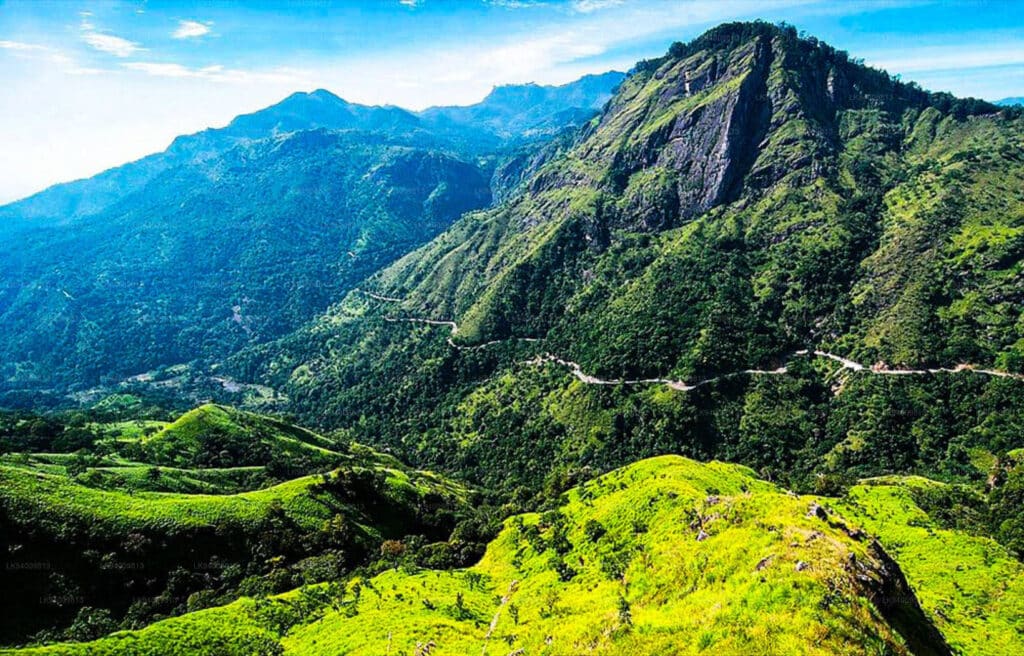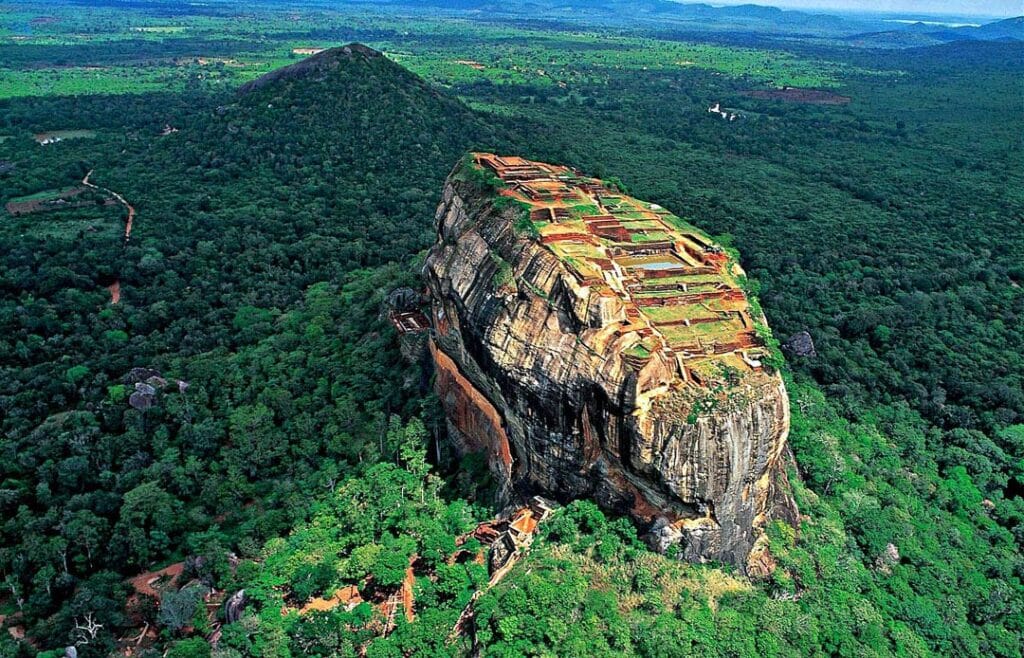There are many hiking places in Sri Lanka. Many tourists only associate Sri Lanka with its lovely, blond beaches, but the country’s untamed, mountainous interior holds a whole other universe. The main method of transportation on this magnificent tropical island was hiking until railways were constructed across the highlands. Within easy striking distance of the shore, modern hikers can reach a paradise of rocky ruins, religious places, spectacular vistas, and falling tea farms.
There aren’t many hard logistics for hikers to worry about thanks to Sri Lanka’s reasonable size—the island is only 268 miles long and 139 miles broad. For walks in national parks (and off-the-beaten-path treks elsewhere), you’ll need a guide, but the majority of excursions are simple day hikes, so you can show up and start walking with confidence that a satisfying plate of rice and curry will be waiting at your guesthouse at the end of a fulfilling day of hiking. Let’s have a look at some interesting places.
Adam’s Peak

The holiest summit in Sri Lanka is respected by Buddhists, Hindus, Muslims, and Christians equally. It is alternatively referred to as Adam’s Peak, Sri Pada (the “holy footprint” left by the Buddha as he traveled towards paradise), and Samanalakande. As much a spiritual journey as it is a physical ascent, the early-morning climb up the 5,200 stairs from the village of Dalhousie to the peak provides a peek into Sri Lanka’s soul and stunning vistas of its natural surroundings.
In December on the poya (full moon) day, through the Vesak holiday in May, is when the majority of people embark on the challenging hike. However, you can start the climb from Dalhousie shortly after night falls to avoid the crowds, who on poya days slow progress to a snail’s pace. Pilgrims begin trekking around 2am in order to reach the peak before daybreak. Catch your breath at the top as you witness the sun’s blessing-like illumination of Sri Lanka, then pay your respects at the imprint left in the rock by the Buddha, Shiva, or Adam.
Hanthana Mountain Range

There are several summits in the Hanthana Mountain Range. The first two summits can be reached in a single day and are ideal for novice hikers. Several entry points are available, one of which is adjacent to the University of Peradeniya. The route is frequently inhabited by bloodthirsty leeches due to its dense grasslands. Climb the tallest mountain, Ura Ketu Gala, and then go to Katusu Konda (another neighboring peak) for an overnight camping trip if you’re feeling very daring. Your hotel in Kandy should be able to simply arrange you a guide for your hike.
Little Adam’s Peak and Ella Rock

Since nearly every guest house in Ella has a map of the tracks and trails that wind between the ridges to tea estates, waterfalls, and overlooks, Ella is the hiking capital of the highlands. It’s simple to spend several days exploring lookouts and posing for photos (or admiring Instagram users do it) next to the iconic Nine Arches Bridge. After a long day of trekking, staying in a guesthouse also means enjoying a delicious home-cooked lunch.
The 4.5km roundtrip to Little Adam’s Peak, a green knoll with fantastic views of waterfalls and tea factories sparkling out of the mist that shrouds the surrounding hills, is an excellent place to start your travels. A prolonged ascent through traditional highland scenery, beginning at Ella Station right on the railroad tracks, makes the 10 km hike to Ella Rock more difficult but also more rewarding. You’ll reach a rocky ledge with breathtaking views of the hill region after a final climb through eucalyptus groves.
Sigiriya & Pidurangula

Although it isn’t a true trip, there is a lot of tramping involved in reaching the top of Sri Lanka’s most famous viewpoint, which is crowned by the remnants of King Kasyapa’s palace. You must ascend over 1,200 stairs to get to the atmospheric scatter of ruins perched atop this commanding granite peak. The view over an enormous expanse of Sri Lankan countryside that stretches to the horizon in all directions is the reward for all of this effort, but be careful of the annoying wasps on the way up!
The 5th-century monastic complex at Pidurangula, perched atop another rocky outcrop to the north of Sigiriya, can be reached after a short distance of walking for views with greater seclusion. A half-hour climb takes you to the summit, where you can see a carpet of forest and the massive mass of Sigiriya rising like a stone exclamation point in the centre of the scene. Along the way, you pass ancient Buddhist temples and carvings. If you arrive by your own means of transportation, you can add on a nighttime stroll to look for slender lorises with the Jetwing Vil Uyana hotel’s on-site naturalist.
Horton Plains & World’s End

No, we’re not talking about the bar on the main drag. The abrupt drop-off at the edge of the Horton Plains in Sri Lanka is known as “World’s End” and offers one of the country’s most breathtaking views. When we refer to “plains,” we really mean a sloping plateau rising to a height of over 2,000 meters, which is dotted with untamed meadows, rocky outcrops, filigree waterfalls, foggy lakes, and pockets of dense forest alive with wildlife.
Since there is no public transportation, you will need to organize a drop-off and pick-up in Nuwara Eliya or Ohiya. Horton Plains National Park is one of the few protected areas where visitors can wander alone. At World’s End, the ground abruptly drops down after a 4 kilometer journey across the plateau. When the weather is fine, the views of the lowlands floating below are spectacular; nevertheless, arrive early in the morning to avoid the throng and the clouds. You’ll need around three hours to accomplish the 9.5km round journey, which includes a loop back to the lovely Baker’s Falls before returning to the Far Inn entrance to the national park.
The Knuckles

Go trekking in Sri Lanka’s heavily forested Knuckles Range, northeast of Kandy, to get off the beaten path. The vulnerable montane and cloud forests on the island are protected by the Peak Wilderness Protected Area, which is designated by Unesco. While hiking in the Knuckles Range, you’ll likely see more residents than tourists as well as more buffalo, monkeys, and birds. In the hazy vegetation, you might perhaps catch a glimpse of a leopard or a wild elephant. However, you must make arrangements through a Kandy-based organization because guides are required.
The term “Knuckles” refers to the shape of these jagged peaks, which from a distance resemble a closed fist. The majority of visitors embark on two-day camping hikes from Kandy, taking in the picturesque little towns and terraced rice fields in the foothills before ascending to the high massif. Typically, agencies travel the park from east to west, spending the night in safari tents and making side trips to caverns and waterfalls along the way. Bring a bird book because you’re very certain to get up close to one of the 128 bird species that live in the park.
Sinharaja Forest Reserve

A biodiverse wonderland bordered by rivers and teeming with forest fauna, including 147 bird species and rare mammals, including 33 species found solely in Sri Lanka, Sinharaja Forest Reserve is the largest lowland rainforest in the nation. Sinharaja can only be reached on foot, not by jeep, and you must have a guide to keep you safe in the thorny, soggy jungle.
The majority of hikers set up camp near the towns of Deniyaya or Kudawa, where you may buy admission tickets and schedule a walk with the tour operators stationed at the park’s entrances. Stay close by to enter the park early in the morning before the tour groups come in from the shore when the paths are empty and the wildlife is most active. A beautiful jungle getaway that won’t break the bank is the Sinharaja Rain Forest View Villas at Deniyaya.
Lipton’s Seat

Visit the village of Haputale in the center of the island, which is submerged in a sea of tea gardens, for a taste—or should that be a sip?—of Sri Lanka’s tea region. Thomas Lipton, whose name continues to be on teabags served at breakfast around the world, established the tea estate in Dambatenne in 1890. The lookout where he arrived to survey the plantations is known as Lipton’s Seat. Despite its historical significance, the viewpoint is a pleasant day trip from Haputale, and you may combine it with a visit to the still-operational Dambatenne Tea Factory to learn about the production of tea.
To get to the overlook from the factory, braided walkways wind through densely populated tea fields where “tea pluckers” fill their bags with the essential ingredient for tomorrow’s cuppas for roughly 8 kilometers. In reality, most tourists do the trip backwards, arriving at Lipton’s Seat by bus or tuk-tuk in the early morning when the views are the clearest, and then making their way through the tea gardens and downhill to the factory.
Stay in Meemure Village

The outside world can no longer find Meemure. The settlement is still far from the nearest towns, and there is no public transportation there. It has no cellular coverage and is located in the Knuckles Mountain Range. The 400-person village is surrounded by breathtaking mountains, paddy fields, and natural swimming holes. Lakegala, a barren outcrop of rock, is one of the mountains. Not for the weak of heart is the climb to Lakegala.
Idalgashinna-Ohiya Railway

One reason to get off the train and follow the railroad tracks is that Sri Lanka has some of the world’s most picturesque train routes. Before you get to Haputale, there is a small village called Idalgashinna. It takes five miles to walk along the railroad rails from Idalgashinna to Ohiya. The trail welcomes you with undulating hills, mist rising over high peaks covered in pine trees, and about 14 tunnels (tunnel numbers 35 to 22). Keep an eye out for trains occasionally, especially if you’re in a tunnel.
When you arrive in Ohiya, stop at a small shop for a fresh cup of Sri Lankan tea before going to the Hill Safari Eco Lodge to spend a night or two.
Dambulla Cave Temple

The central region of Sri Lanka is a fantastic destination to experience the Buddhist legacy of Sri Lanka and is better known as the Golden Cave Temple due to the exquisitely painted granite caverns in the boulder jungle. Numerous figures are in the hundreds, and the cave temple’s painted ceiling spans thousands of square meters. A UNESCO world heritage monument and one of the oldest temples in the world, dating back to the first century BC, attracts pilgrims from all over the island to this location.
The Dambulla Golden Cave Temple, which is situated in the center of the triangle formed by Kandy, Polonnaruwa, and Anuradhapura, is a crucial component in Sri Lanka’s cultural triangle. The archaeological agency is currently in charge of the Dambulla cave temple. About 181 kilometers from Colombo, the temple is situated close to the town of Dambulla. The mountain where the temple is situated is regarded as one of Sri Lanka’s top treks. The climb to the cave temple takes about 30 minutes from the mountain’s base. Granite steps with good pavement go up to the temple.
Nasdanda Mountain

The second-highest mountain in Sri Lanka is Kirigalpoththa. With a peak elevation of 2388 meters above mean sea level, this mountain is also the tallest in the nation whose summit is reachable by hikers (the highest mountain is Piduruthalagala, although it is home to a military base and is off-limits to the general public). Although the trail is not very well-traveled, it offers fascinating experiences to hikers as they navigate varied terrains and barriers to reach the mountain’s peak via Horton Plains National Park.
The 7000-meter Kirigalpoththa path, the highest point in Horton Plains National Park, will need about 512 hours of hiking and mountaineering challenges through the park’s beautiful natural surroundings.Hikers occasionally encounter Leopards and Sambar Deer, which are found exclusively in Southern Asia. If you’re lucky, you might even see the endemic Bear Monkey, which is found in Horton Plains National Park, taking your hiking experience to a whole new level.
Hikers’ fatigue will vanish as they trek through the grassy plains, cloud forest, swamp, and breathtaking scenery, giving them extra vigor to reach the summit.
There are more hiking places in sri lanka and I just tried to give some idea about popular places. If you visit to Sri Lanka, you should visit these places definitely.



